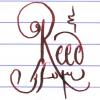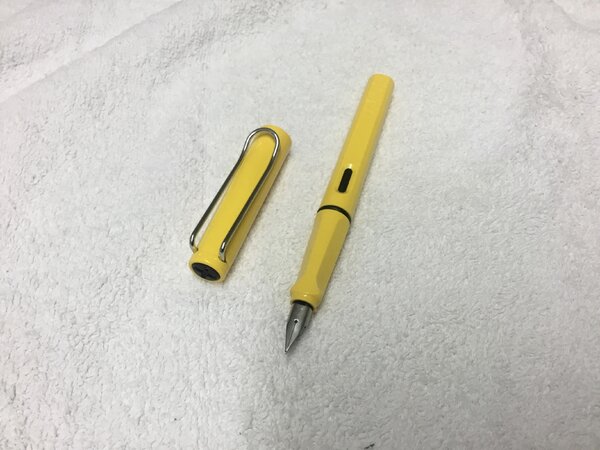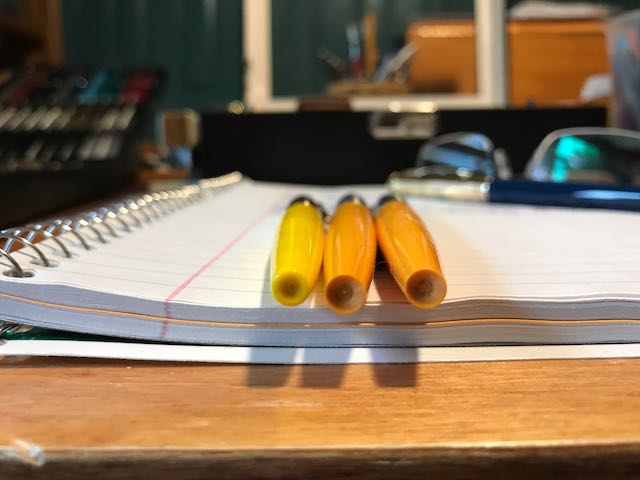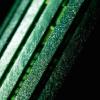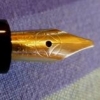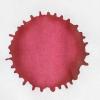Search the Community
Showing results for tags 'yellow'.
-
Someone on Reddit asked me to compare the tones of two of these pens and I gathered up all my yellow pens for this photo. The pens are: Hero XXX, Jinhao 100, Wing Sung 630, Moonman T60, Hongdian C1, Moonman A2, Hongdian C3.
-

Yellow Pen Club - Show Us Your Yellow Pens!
Misfit posted a topic in Fountain & Dip Pens - First Stop
The Pen Clubs continue with a challenge, yellow pens. We will start other pen clubs, and some of those should have lots of contributions. Let’s see how many yellow pens people buy. I have five. From left: Pilot Prera yellow Nemosine Singularity Sunglow... -
TACCIA Ukiyo-e Syaraku natane TACCIA is a Japanese stationery company, that - as far as I know - is now part of the Nakabayashi group. They offer high-quality fountain pens, inks, pen-rolls, notebooks, etc. More specifically, TACCIA produces a line of inks, inspired by the unique look of Uki...
- 7 replies
-
- taccia ukiyo-e
- syaraku
-
(and 3 more)
Tagged with:
-
I got this one on a whim, thinking I might need a yellow. It's not suitable for writing as you cannot see what you're doing and while the scan and photos make it legible, I cannot read the page, over powered by this arguably bright yellow. It's a dry ink and wrote awful in the Soennecken. And it was...
- 12 replies
-
- j herbin
- bouton dor
-
(and 3 more)
Tagged with:
-
From the album: Mercian’s pens
My (currently) latest acquisition - a Lamy Safari in standard-production-run yellow, with an ‘F’ nib. #Glamorous It reminds me very much of a Lego construction set that I was given in the early 1980s 😊
- 0 B
- x
-
I'm a Parker 45 collector (among other pens). My impression is that the "Happy Colors" Yellow is quite hard to find. I have two FPs of one type of yellow, and one of another type of yellow. See the photos here from different distances and perspectives: Based mostly on the photo of the barr...
-
TAG Kyoto – kyo-no-oto – yamabukiiro TAG is a stationery shop in Kyoto (Japan) that produces some interesting soft watercolour-style inks. With the kyo-no-oto series they produce a line of inks that replicates traditional Japanese dye colours. According to available online info,...
- 10 replies
-
- tag kyoto
- kyo-no-oto
-
(and 3 more)
Tagged with:
-
Manufacturer: Robert Oster Signature Series, colour: Yellow Sunrise Pen: Waterman Hemisphere „F” Paper: Image Volume (gramatura 80 g / m2) Specifications: Flow rate: very good Lubrication: good Bleed through: unnoticeable Shading: noticeable Feathering: unnoticeable Saturation: very good A dr...
- 6 replies
-
- robert oster signature
- yellow sunrise
-
(and 1 more)
Tagged with:
-
My preordered TWBI ECO in yellow arrived in the mail today. YAY!!! I was thrilled to see that it wasn't a dull orange-yellow or an eye-stabbing neon yellow, nor yet a depressing school bus yellow (which never fails to look dingy to my eye). Nope! What I have is a sunny cheerful yellow. See it be...
-
Robert Oster 1980 - Honey Bee Robert Oster is an Australian ink maker that is well-known for its unique range of colours. With this mini-series he gives us a conglomeration of colours inspired by the anything goes world of the 1980s. These inks fit my personal preferences: muted pastel-type...
- 6 replies
-
- robert oster
- robert oster 1980
-
(and 4 more)
Tagged with:
-
Hello again to all my FPN friends, One of the interesting things for me about this hobby is how easily and suddenly my preferences for a particular design or color can change. I never use yellow for anything other than highlighting and previously would have thought something like a yellow pen to b...
-
Why is it so hard to find yellow ballpoint pen. I mean yellow ink ballpoint pen. I have yellow fountain pen ink. Yellow gel pens. Yellow pencils. you can find yellow in almost all art supplies. And when you want ballpoint pens, where is yellow? I have visited many art stores. I have purchased these...
-
Robert Oster Signature - Green Olive Robert Oster is an Australian ink maker that is well-known for his unique range of colours. On his website, he describes our shared love quite eloquently: "Robert Oster Signature originates from one of the most famous wine producing regions of the world, the...
- 3 replies
-
- robert oster
- signature
-
(and 2 more)
Tagged with:
-
Hello, I have stumbled across a vintage Lamy pen I cannot properly identify and date. Any information on production year, collectibility and value of the pen will be greatly appreciated. I am unable to post any photographs as of right now, but if necessary, they will be posted as soon as I am able...
-
Hello there, Recently, I do a lot of pen maintenance mostly on vintage Montblancs. With this I realize the different colorations of some of the Montblanc stars on these pens which range from snow white over somewhat yellow to banana yellow. Here is a picture of a 344, a 252 and a 342 - all in diff...
-
Ink Review: STIPULA CALAMO SAPPHRON I have wanted to try several of the Stipula Calamo inks for some time after hearing about them. The inks are handmade in Italy and come in this great 70mL bottle. The Review above was scanned, and the color is "washed out". The ink color is closes...
-
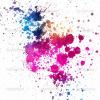
Diamine Sunshine Yellow, Robert Oster Yellow Sunset, Diamine Amber, Robert Oster Peach
Jan2016 posted a topic in Ink Comparisons
Not the same, but all 4 pretty close to each other, see the chromo's- 5 replies
-
- diamine
- robert oster
-
(and 8 more)
Tagged with:
-
Penbbs is chinese fountain pen forum. It seems the guys are not only talking about pens but also mixing inks and the moment they've created approximnately 200 inks. Wow. I remember I've seen Lgsoltek reviews of their inks and I had a chance to try opuntia Stricta ink that was rather nice in terms of...
- 24 replies
-
- penbbs
- chinese ink
-
(and 1 more)
Tagged with:
-
- 3 replies
-
- lartisan pastellier
- callifolio
-
(and 8 more)
Tagged with:
-
- 3 replies
-
- robert oster
- yellow sunset
-
(and 5 more)
Tagged with:
-
- 13 replies
-
- j herbin
- bouton dor
-
(and 3 more)
Tagged with:
-
- 11 replies
-
- robert oster
- green olive
-
(and 8 more)
Tagged with:
-
- 3 replies
-
- diamine
- golden sands
- (and 8 more)
-
- 9 replies
-
- kyo no oto
- kyonooto
-
(and 8 more)
Tagged with:




